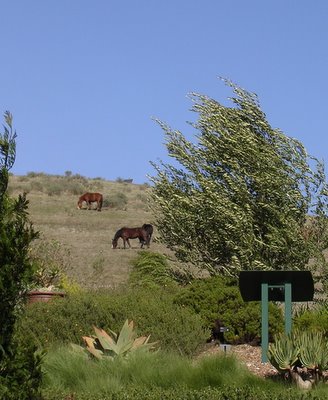Georgics
Vergil wrote this long poem about agriculture and rural life between 29 and 22 BCE and dedicated it to the Emperor Augustus. Its title derives from the Greek word for Earth--Ge or Gaia, and Ergon, or work: earth-work. I was prompted to reread it after spending time in the countryside of northern Italy last October. Its rich descriptions still apply to landscapes and methods of cultivation found there today, and its subject matter and style remind me of contemporary poets like Frost and Wendell Berry. A book called American Georgics by Timothy Sweet convinced me that it would be worthwhile to include early in the Ecolit course as a precursor of Walden.
I'd told students that our second class would include a hike of the horse canyon loop but I doubted we could fit that into the palty 85 minutes we'd have, given the need to schedule fifteen minutes at start and conclusion for leaving and returning to the central campus. I was also planning a discussion of the Georgics and its relation to pastoral traditions, some linkages between passages in the text and what we might encounter along the way, and a twenty minute interlude for quiet reflection and writing in journals. As much as possible I would use the peripatetic method of lecture, urging students to move fast in a tight knot, walking backwards and shouting. In the construction sites and parking lots along Via Carta we talked of heritage trees that were saved from the bulldozer by the intervention of enviromentalists, and threats to Brizzolara Creek, the central artery of the campus watershed. Students in Animal Science and Biology contributed much to the walkalong lesson.
At the Equine Unit, Kristy who had been there the day before caring for pregnant mares, led us past a mother and her one day old foal

to the enclosure where the mares were sequestered and given royal treatment, along the lines penned by Vergil:
 Kristy's friend showed up with a bucket of grain she was bringing the ladies in her charge and filled us in on some of the niceties of breeding horses carried out on campus, largely through artificial insemination. This involves exciting a stallion with "teaser" mares, letting him mount a decoy, and then harvesting his sperm in a long tube known as an artificial vagina. She warned us to stay away from the dangerous rutting stallions, and I read Vergil's sound painting of the stormy passion that drives both animals and humans:
Kristy's friend showed up with a bucket of grain she was bringing the ladies in her charge and filled us in on some of the niceties of breeding horses carried out on campus, largely through artificial insemination. This involves exciting a stallion with "teaser" mares, letting him mount a decoy, and then harvesting his sperm in a long tube known as an artificial vagina. She warned us to stay away from the dangerous rutting stallions, and I read Vergil's sound painting of the stormy passion that drives both animals and humans:
Walking through the greenhouses we spoke of alternative methods of pest management and outside near the experimental turf plots and formal gardens, we considered alternative directions for horticultural science: sustainable and unsustainable. As we entered the Arboretum's California Gardens, I talked about how they inspired me to rip out my old lawns and shrubs and sprinkler systems and plant the California natives which require fews inputs and create no waste--with the guidance of ex Ecolit student and present day manager Chris who was working down the path.
Stopping by a beautiful white-limbed specimen of California buckeye--the genus of Aesculus mentioned several times by Vergil when he speaks of the Italian chestnut and horse chestnut-- we noticed the winter-spring buds swelling at the growing tips of twigs and bursting from the middle of thick branches bare to the light stimulus of the southern sun. Passing through a damp grove of redwoods, we came upon the experimental Carex plot, after the recent rains greener and fuller than I've ever seen it, proof that the right native perennial bunch grass can replace the water and chemical dependent lawns that are depleting our naturally arid lands.
At the end of the garden we observed the great scar of the quarry-dump on Poly Mountain overlooking the future site of the 2700 resident Student Housing North development, while a redtail hawk circled overhead showing off his bright underwings. What was supposed to have been a hike turned out a brief stroll concluded with fifteen minutes of journaling and repose on a circle of stones in the shade of a cypress tree.
"A wild Santa Ana wind blew off a shingle last night, the first one since the roof was laid fifteen years ago. Now it's a steady breeze from the east making ripples on Drumm reservoir that sparkle among silver clumps of deergrass.

A meadowlark yodels on a fencepost at the edge of the old Bull Test's flourescent green pasture. Never again will it be manured and cropped down to dirt. At the foot of Caballo Peak the mares nibble in the lovely surroundings Vergil recommends.

The ground feels good under the base of my spine: serpentine gravel and sun-bleached chips of mulch."
I'd told students that our second class would include a hike of the horse canyon loop but I doubted we could fit that into the palty 85 minutes we'd have, given the need to schedule fifteen minutes at start and conclusion for leaving and returning to the central campus. I was also planning a discussion of the Georgics and its relation to pastoral traditions, some linkages between passages in the text and what we might encounter along the way, and a twenty minute interlude for quiet reflection and writing in journals. As much as possible I would use the peripatetic method of lecture, urging students to move fast in a tight knot, walking backwards and shouting. In the construction sites and parking lots along Via Carta we talked of heritage trees that were saved from the bulldozer by the intervention of enviromentalists, and threats to Brizzolara Creek, the central artery of the campus watershed. Students in Animal Science and Biology contributed much to the walkalong lesson.
At the Equine Unit, Kristy who had been there the day before caring for pregnant mares, led us past a mother and her one day old foal

to the enclosure where the mares were sequestered and given royal treatment, along the lines penned by Vergil:
To care of sire the mother's care succeeds.
When great with young they wander nigh their time,
Let no man suffer them to drag the yoke
In heavy wains, nor leap across the way,
Nor scour the meads, nor swim the rushing flood.
In lonely lawns they feed them, by the course
Of brimming streams, where moss is, and the banks
With grass are greenest, where are sheltering caves,
And far outstretched the rock-flung shadow lies.
 Kristy's friend showed up with a bucket of grain she was bringing the ladies in her charge and filled us in on some of the niceties of breeding horses carried out on campus, largely through artificial insemination. This involves exciting a stallion with "teaser" mares, letting him mount a decoy, and then harvesting his sperm in a long tube known as an artificial vagina. She warned us to stay away from the dangerous rutting stallions, and I read Vergil's sound painting of the stormy passion that drives both animals and humans:
Kristy's friend showed up with a bucket of grain she was bringing the ladies in her charge and filled us in on some of the niceties of breeding horses carried out on campus, largely through artificial insemination. This involves exciting a stallion with "teaser" mares, letting him mount a decoy, and then harvesting his sperm in a long tube known as an artificial vagina. She warned us to stay away from the dangerous rutting stallions, and I read Vergil's sound painting of the stormy passion that drives both animals and humans:Nay, every race on earth of men, and beasts,My watch battery had run down but I knew time was sliding by, so I decided to forgo the hike in favor of a tour of the Horticultural Unit and the Leaning Pine Arboretum. Alluding to what I learned from Animal Science Professor Rob Rutherford, I pointed out that the production of food and fibre was the original purpose of Agriculture and the School of Agriculture that Cal Poly started out as. But following the industry and the money, the fastest growing departments here now were Equine Science and Horticulture. These are dedicated to recreation and decoration, since that's where the jobs and resources of our luxury-oriented economy are directed.
And ocean-folk, and flocks, and painted birds,
Rush to the raging fire: love sways them all.
Never than then more fiercely o'er the plain
...
Mark you what shivering thrills the horse's frame,
If but a waft the well-known gust conveys?
Nor curb can check them then, nor lash severe,
Nor rocks and caverned crags, nor barrier-floods,
That rend and whirl and wash the hills away.
Then speeds amain the great Sabellian boar,
His tushes whets, with forefoot tears the ground,
Rubs 'gainst a tree his flanks, and to and fro
Hardens each wallowing shoulder to the wound.
What of the youth, when love's relentless might
Stirs the fierce fire within his veins? Behold!
In blindest midnight how he swims the gulf
Convulsed with bursting storm-clouds! Over him
Heaven's huge gate thunders; the rock-shattered main
Utters a warning cry; nor parents' tears
Can backward call him, nor the maid he loves,
Too soon to die on his untimely pyre.
Walking through the greenhouses we spoke of alternative methods of pest management and outside near the experimental turf plots and formal gardens, we considered alternative directions for horticultural science: sustainable and unsustainable. As we entered the Arboretum's California Gardens, I talked about how they inspired me to rip out my old lawns and shrubs and sprinkler systems and plant the California natives which require fews inputs and create no waste--with the guidance of ex Ecolit student and present day manager Chris who was working down the path.
Stopping by a beautiful white-limbed specimen of California buckeye--the genus of Aesculus mentioned several times by Vergil when he speaks of the Italian chestnut and horse chestnut-- we noticed the winter-spring buds swelling at the growing tips of twigs and bursting from the middle of thick branches bare to the light stimulus of the southern sun. Passing through a damp grove of redwoods, we came upon the experimental Carex plot, after the recent rains greener and fuller than I've ever seen it, proof that the right native perennial bunch grass can replace the water and chemical dependent lawns that are depleting our naturally arid lands.
At the end of the garden we observed the great scar of the quarry-dump on Poly Mountain overlooking the future site of the 2700 resident Student Housing North development, while a redtail hawk circled overhead showing off his bright underwings. What was supposed to have been a hike turned out a brief stroll concluded with fifteen minutes of journaling and repose on a circle of stones in the shade of a cypress tree.
"A wild Santa Ana wind blew off a shingle last night, the first one since the roof was laid fifteen years ago. Now it's a steady breeze from the east making ripples on Drumm reservoir that sparkle among silver clumps of deergrass.

A meadowlark yodels on a fencepost at the edge of the old Bull Test's flourescent green pasture. Never again will it be manured and cropped down to dirt. At the foot of Caballo Peak the mares nibble in the lovely surroundings Vergil recommends.

The ground feels good under the base of my spine: serpentine gravel and sun-bleached chips of mulch."


0 Comments:
Post a Comment
<< Home